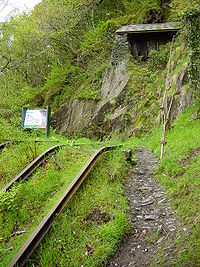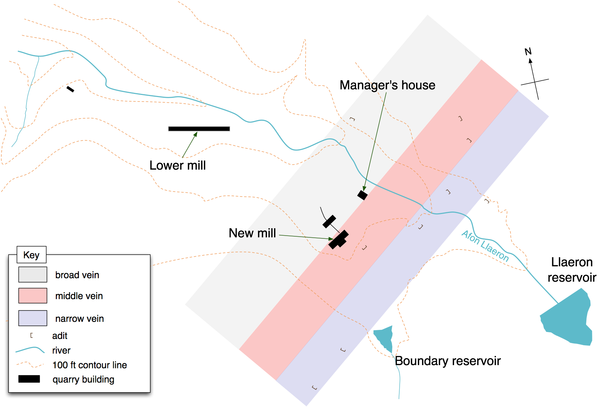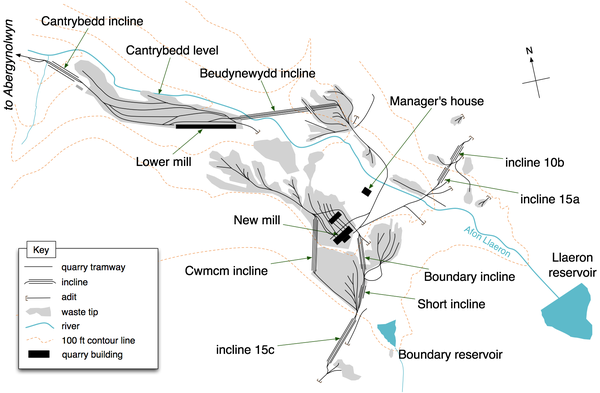
Bryn Eglwys
Encyclopedia

Slate industry in Wales
The slate industry in Wales began during the Roman period when slate was used to roof the fort at Segontium, now Caernarfon. The slate industry grew slowly until the early 18th century, then expanded rapidly until the late 19th century, at which time the most important slate producing areas were in...
quarry
Quarry
A quarry is a type of open-pit mine from which rock or minerals are extracted. Quarries are generally used for extracting building materials, such as dimension stone, construction aggregate, riprap, sand, and gravel. They are often collocated with concrete and asphalt plants due to the requirement...
located near Abergynolwyn
Abergynolwyn
Abergynolwyn is a village in southern Gwynedd, Wales, located at the confluence of the Nant Gwernol and the Afon Dysynni.Historically, the village was part of Merionethshire and its main industry was slate quarrying and the village was founded in the 1860s to house workers at the nearby Bryn...
in Gwynedd
Gwynedd
Gwynedd is a county in north-west Wales, named after the old Kingdom of Gwynedd. Although the second biggest in terms of geographical area, it is also one of the most sparsely populated...
mid-Wales
Wales
Wales is a country that is part of the United Kingdom and the island of Great Britain, bordered by England to its east and the Atlantic Ocean and Irish Sea to its west. It has a population of three million, and a total area of 20,779 km²...
.
History

William McConnel
William McConnel was an industrialist and mill-owner from Lancashire, England. He founded the Aberdovey Slate Company that ran the Bryn Eglwys slate quarry from 1863 onwards and oversaw the construction of the associated Talyllyn Railway....
leased the quarry, forming the Aberdovey Slate Company Limited. McConnel planned to increase production at Bryn Eglwys. The limiting factor was the transportation of finished slates by pack horse to the wharves at Aberdovey. To overcome this, McConnel built the Talyllyn Railway
Talyllyn Railway
The Talyllyn Railway is a narrow-gauge preserved railway in Wales running for from Tywyn on the Mid-Wales coast to Nant Gwernol near the village of Abergynolwyn. The line was opened in 1866 to carry slate from the quarries at Bryn Eglwys to Tywyn, and was the first narrow gauge railway in Britain...
, a narrow gauge line running from the quarry to Tywyn
Tywyn
Tywyn is a town and seaside resort on the Cardigan Bay coast of southern Gwynedd , in north Wales. The name derives from the Welsh tywyn and the town is sometimes referred to as Tywyn Meirionnydd...
, where slate could be transhipped to the newly built Aberystwyth and Welsh Coast Railway
Aberystwyth and Welsh Coast Railway
The Aberystwith and Welsh Coast Railway was a standard gauge railway built in 1863 connecting major towns on the Welsh coast.- History :...
.
The railway ran to , a lonely spot about 430 feet below the main quarry level. From there the half-mile long Galltymoelfre Tramway and a pair of inclines
Cable railway
A cable railway is a steeply graded railway that uses a cable or rope to haul trains.-Introduction:...
connected to the quarry.
Neither the quarry nor its associated railway were great commercial successes. By 1879 the company had run out of funds and both were auctioned off on 9 October 1879. After this and a subsequent auction failed to find a bidder, William McConnel personally bought both, and an upturn in the slate market allowed the quarry to expand further.
McConnel died in 1902 and the quarry became the property of his son W.H. McConnel. However the leases on the land the quarry occupied were close to running out and Bryn Eglwys ceased production in 1909.
In 1911 the local Liberal
Liberal Party (UK)
The Liberal Party was one of the two major political parties of the United Kingdom during the 19th and early 20th centuries. It was a third party of negligible importance throughout the latter half of the 20th Century, before merging with the Social Democratic Party in 1988 to form the present day...
Member of Parliament
Member of Parliament
A Member of Parliament is a representative of the voters to a :parliament. In many countries with bicameral parliaments, the term applies specifically to members of the lower house, as upper houses often have a different title, such as senate, and thus also have different titles for its members,...
Henry Haydn Jones
Henry Haydn Jones
Sir Henry Haydn Jones was a Welsh Liberal Party politician.- Upbringing :Henry Haydn Jones was born in Ruthin, Wales. He was the son of Joseph David Jones , a schoolmaster in the town and a respected Welsh musician and composer...
purchased the quarry, along with the Talyllyn Railway and the village of Abergynolwyn, forming the Abergynolwyn Slate & Slab Co. Ltd. New leases were signed with the landowners and the quarry resumed production.
The quarry remained in production until a serious collapse on December 26, 1946 - it had been unsafe for some time.
Geology

Three parallel veins
Stratum
In geology and related fields, a stratum is a layer of sedimentary rock or soil with internally consistent characteristics that distinguish it from other layers...
of Ordovician
Ordovician
The Ordovician is a geologic period and system, the second of six of the Paleozoic Era, and covers the time between 488.3±1.7 to 443.7±1.5 million years ago . It follows the Cambrian Period and is followed by the Silurian Period...
slate run through mid Wales, from the region north of Dinas Mawddwy
Dinas Mawddwy
Dinas Mawddwy is a village in Gwynedd, north Wales, just to the side of the A470 so that most visitors pass the village by. Its population is roughly 600. The village marks the junction of the unclassified road to Llanuwchllyn which climbs up through the mountains to cross Bwlch y Groes at its...
through Corris
Corris
Corris is a village in the south of Snowdonia in the Welsh county of Gwynedd. Although the Snowdonia National Park covers much of the area around Corris, the village is not within the park. The name is possibly derived from the English word "quarries", and the extensive slate quarries that surround...
and south west towards Tywyn
Tywyn
Tywyn is a town and seaside resort on the Cardigan Bay coast of southern Gwynedd , in north Wales. The name derives from the Welsh tywyn and the town is sometimes referred to as Tywyn Meirionnydd...
. These veins are the southern edge of the Harlech Dome anticline
Anticline
In structural geology, an anticline is a fold that is convex up and has its oldest beds at its core. The term is not to be confused with antiform, which is a purely descriptive term for any fold that is convex up. Therefore if age relationships In structural geology, an anticline is a fold that is...
which surfaces in the north at Blaenau Ffestiniog
Blaenau Ffestiniog
Blaenau Ffestiniog is a town in Gwynedd, north-west Wales. It has a population of 5,000, including Llan Ffestiniog, which makes it the third largest town in Gwynedd, behind Caernarfon & Porthmadog. Although the population reached 12,000 at the peak of the slate industry, the population fell due to...
. Where the veins cross the site of Bryn Eglwys, they are inclined at an angle of about 30 degrees from the horizontal, sloping downwards to the south-west. The widest of these veins is the 600-ft-thick "Broad Vein" that lies to the north of site and consists of layers of hard, grey shale
Shale
Shale is a fine-grained, clastic sedimentary rock composed of mud that is a mix of flakes of clay minerals and tiny fragments of other minerals, especially quartz and calcite. The ratio of clay to other minerals is variable. Shale is characterized by breaks along thin laminae or parallel layering...
with patches of slate. The Broad Vein slate is hard and durable, but does not split into thin sections, so is generally unsuitable for use as roofing slates.
The "Middle Vein" (sometimes known as the "Red Vein") lies about 100 yards south of the Broad Vein. It is about 60 ft thick but contains low-quality, friable
Friability
Friability is the ability of a solid substance to be reduced to smaller pieces with little effort. The opposite of friable is indurated....
slate that contains a large number of fossil
Fossil
Fossils are the preserved remains or traces of animals , plants, and other organisms from the remote past...
s, predominately graptolites.
This vein was not worked commercially at Bryn Eglwys.
The third vein is the "Narrow Vein" which lies about 100 yards south of the Middle Vein and is also about 60 ft thick. It contains the highest quality slate of the three veins and the most commercially valuable, being easy to split into roofing slates and slabs and both durable and strong. The vein is mostly a continuous bed of slate, containing only the occasional seam of quartz
Quartz
Quartz is the second-most-abundant mineral in the Earth's continental crust, after feldspar. It is made up of a continuous framework of SiO4 silicon–oxygen tetrahedra, with each oxygen being shared between two tetrahedra, giving an overall formula SiO2. There are many different varieties of quartz,...
. However the quality of the rock varies over the depth of the vein, with the best material found nearest the surface.
Description


